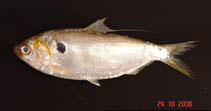Add your observation in Fish Watcher
| Native range | All suitable habitat | Point map | Year 2050 |

|
| This map was computer-generated and has not yet been reviewed. |
| Konosirus punctatus AquaMaps Data sources: GBIF OBIS |
Upload your photos and videos
Pictures | Google imageKonosirus punctatus
Picture by Liu, J.
Pictures | Google imageKonosirus punctatus
Picture by Liu, J.
Korea (South) country information
Common names:
Chǒn-ǒ, Dotted gizzard shad, 전어
Occurrence: native
Salinity: brackish
Abundance: | Ref:
Importance: | Ref:
Aquaculture: | Ref:
Regulations: | Ref:
Uses: no uses
Comments: Collected from the Sumjin river (Ref. 58345), coastal waters of Tongyeong (Ref. 49924) and Gadeok-do (Ref. 37629), and Suyoung Bay (Ref. 37630). Also Ref. 188.
National Checklist:
Country Information: https://www.cia.gov/library/publications/resources/the-world-factbook/geos/ks.html
National Fisheries Authority:
Occurrences: Occurrences Point map
Main Ref: Kim, I.S., Y. Choi, C.L. Lee, Y.J. Lee, B.J. Kim and J.H. Kim, 2005
National Database:
Occurrence: native
Salinity: brackish
Abundance: | Ref:
Importance: | Ref:
Aquaculture: | Ref:
Regulations: | Ref:
Uses: no uses
Comments: Collected from the Sumjin river (Ref. 58345), coastal waters of Tongyeong (Ref. 49924) and Gadeok-do (Ref. 37629), and Suyoung Bay (Ref. 37630). Also Ref. 188.
National Checklist:
Country Information: https://www.cia.gov/library/publications/resources/the-world-factbook/geos/ks.html
National Fisheries Authority:
Occurrences: Occurrences Point map
Main Ref: Kim, I.S., Y. Choi, C.L. Lee, Y.J. Lee, B.J. Kim and J.H. Kim, 2005
National Database:
Common names from other countries
Classification / Names Common names | Synonyms | Catalog of Fishes(genus, species) | ITIS | CoL | WoRMS | Cloffa
Teleostei (teleosts) > Clupeiformes (Herrings) > Dorosomatidae (Gizzard shads and sardinellas)
Etymology: Konosirus: Japanese, konoshiro, a fish eaten in Kumihama City, in the Sea of Japan.
More on authors: Temminck & Schlegel.
Etymology: Konosirus: Japanese, konoshiro, a fish eaten in Kumihama City, in the Sea of Japan.
More on authors: Temminck & Schlegel.
Environment: milieu / climate zone / depth range / distribution range Ecology
Marine; brackish; pelagic-neritic; oceanodromous (Ref. 51243). Subtropical; 42°N - 23°N, 117°E - 138°E (Ref. 54453)
Distribution Countries | FAO areas | Ecosystems | Occurrences | Point map | Introductions | Faunafri
Indo-West Pacific: coasts of Japan from about 38°N southward; Sea of Japan north to Vladivostok on mainland; also Yellow Sea, including Gulf of Pohai and East China Sea south to Taiwan Island and Hong Kong).
Length at first maturity / Size / Weight / Age
Short description Identification keys | Morphology | Morphometrics
Dorsal spines (total): 0; Anal spines: 0; Anal soft rays: 192 - 27. Body moderately slender, moderately compressed, belly with 17 to 21 (usually 19 or 20) + 12 to 16 (usually 14 or 15), total 32 to 37 (usually 34 or 35) scutes; no pre-dorsal scutes. Snout projecting slightly; gill rakers of first arch at least 3/4 length of gill filaments. Vertebrae 46 to 51 (usually 49, also 48 or 51). A dark spot behind gill opening, followed by several lines of dark dots.
Found off coasts and in bays, but migrating into shallower brackish water for breeding, at least in Ariake Sound (south Kyushu), where spawning takes place far up the Sound in April and May. Individuals apparently spawn twice or more during the season.
Life cycle and mating behavior Maturity | Reproduction | Spawning | Eggs | Fecundity | Larvae
Main reference
Upload your references | References | Coordinator | Collaborators
Whitehead, P.J.P., 1985. FAO Species Catalogue. Vol. 7. Clupeoid fishes of the world (suborder Clupeoidei). An annotated and illustrated catalogue of the herrings, sardines, pilchards, sprats, shads, anchovies and wolf-herrings. FAO Fish. Synop. 125(7/1):1-303. Rome: FAO. (Ref. 188)
IUCN Red List Status (Ref. 130435: Version 2024-2)
Least Concern (LC) ; Date assessed: 28 February 2017
Threat to humans
Harmless
Human uses
Fisheries: minor commercial
FAO(Aquaculture systems: production; Fisheries: production, species profile; publication : search) | FishSource | Sea Around Us
More information
Population dynamics
Growth parameters
Max. ages / sizes
Length-weight rel.
Length-length rel.
Length-frequencies
Mass conversion
Recruitment
Abundance
Growth parameters
Max. ages / sizes
Length-weight rel.
Length-length rel.
Length-frequencies
Mass conversion
Recruitment
Abundance
Anatomy
Gill area
Brain
Otolith
Gill area
Brain
Otolith
Physiology
Body composition
Nutrients
Oxygen consumption
Swimming type
Swimming speed
Visual pigments
Fish sound
Diseases & Parasites
Toxicity (LC50s)
Body composition
Nutrients
Oxygen consumption
Swimming type
Swimming speed
Visual pigments
Fish sound
Diseases & Parasites
Toxicity (LC50s)
Genetics
Genetics
Heterozygosity
Heritability
Genetics
Heterozygosity
Heritability
Human related
Aquaculture systems
Aquaculture profiles
Strains
Ciguatera cases
Stamps, coins, misc.
Aquaculture systems
Aquaculture profiles
Strains
Ciguatera cases
Stamps, coins, misc.
Tools
E-book | Field guide | Identification keys | Length-frequency wizard | Life-history tool | Point map | Classification Tree
| Catch-MSY |
Special reports
Download XML
Internet sources
Aquatic Commons | BHL | Cloffa | Websites from users | Check FishWatcher | CISTI | Catalog of Fishes(genus, species) | DiscoverLife | ECOTOX | Faunafri | Fishtrace | GenBank(genome, nucleotide) | GloBI | GOBASE | | Google Books | Google Scholar | Google | IGFA World Record | MitoFish | National databases | Otolith Atlas of Taiwan Fishes | PubMed | Reef Life Survey | Scirus | SeaLifeBase | Tree of Life | Wikipedia(Go, Search) | World Records Freshwater Fishing | Zoological Record
Estimates based on models
Preferred temperature (Ref. 115969): 16.1 - 23.8, mean 20.3 (based on 86 cells).
Phylogenetic diversity index (Ref. 82804): PD50 = 1.0000 [Uniqueness, from 0.5 = low to 2.0 = high].
Bayesian length-weight: a=0.00851 (0.00748 - 0.00969), b=3.05 (3.02 - 3.08), in cm Total Length, based on LWR estimates for this species (Ref. 93245).
Trophic level (Ref. 69278): 2.9 ±0.24 se; based on food items.
Resilience (Ref. 120179): High, minimum population doubling time less than 15 months (Assuming tm=1).
Fishing Vulnerability (Ref. 59153): Moderate vulnerability (36 of 100).
Climate Vulnerability (Ref. 125649): High to very high vulnerability (65 of 100).




